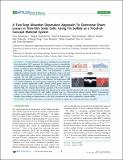A Two-Step Absorber Deposition Approach To Overcome Shunt Losses in Thin-Film Solar Cells: Using Tin Sulfide as a Proof-of-Concept Material System
Author(s)
Yang, Chuanxi; Moriarty, Tom; Gordon, Roy G.; Buonassisi, Tonio; Steinmann, Vera; Chakraborty, Rupak; Rekemeyer, Paul Harlan; Hartman, Katherine; Brandt, Riley E; Polizzotti, James Alexander; Gradecak, Silvija; ... Show more Show less
DownloadBuonassis_A two-step absorber.pdf (307.6Kb)
PUBLISHER_POLICY
Publisher Policy
Article is made available in accordance with the publisher's policy and may be subject to US copyright law. Please refer to the publisher's site for terms of use.
Terms of use
Metadata
Show full item recordAbstract
As novel absorber materials are developed and screened for their photovoltaic (PV) properties, the challenge remains to reproducibly test promising candidates for high-performing PV devices. Many early-stage devices are prone to device shunting due to pinholes in the absorber layer, producing “false-negative” results. Here, we demonstrate a device engineering solution toward a robust device architecture, using a two-step absorber deposition approach. We use tin sulfide (SnS) as a test absorber material. The SnS bulk is processed at high temperature (400 °C) to stimulate grain growth, followed by a much thinner, low-temperature (200 °C) absorber deposition. At a lower process temperature, the thin absorber overlayer contains significantly smaller, densely packed grains, which are likely to provide a continuous coating and fill pinholes in the underlying absorber bulk. We compare this two-step approach to the more standard approach of using a semi-insulating buffer layer directly on top of the annealed absorber bulk, and we demonstrate a more than 3.5× superior shunt resistance R[subscript sh] with smaller standard error σ[subscript Rsh]. Electron-beam-induced current (EBIC) measurements indicate a lower density of pinholes in the SnS absorber bulk when using the two-step absorber deposition approach. We correlate those findings to improvements in the device performance and device performance reproducibility.
Date issued
2016-08Department
Massachusetts Institute of Technology. Department of Materials Science and Engineering; Massachusetts Institute of Technology. Department of Mechanical EngineeringJournal
ACS Applied Materials & Interfaces
Publisher
American Chemical Society (ACS)
Citation
Steinmann, Vera et al. “A Two-Step Absorber Deposition Approach To Overcome Shunt Losses in Thin-Film Solar Cells: Using Tin Sulfide as a Proof-of-Concept Material System.” ACS Applied Materials & Interfaces 8, 34 (August 2016): 22664–22670 © 2016 American Chemical Society
Version: Author's final manuscript
ISSN
1944-8244
1944-8252